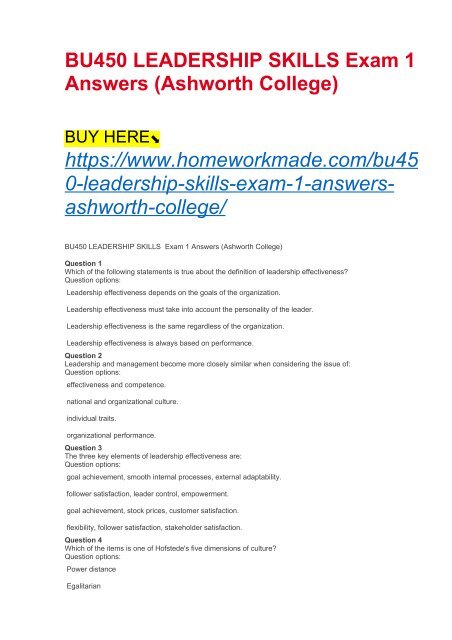BU450 LEADERSHIP SKILLS Exam 1 Answers (Ashworth College)
You also want an ePaper? Increase the reach of your titles
YUMPU automatically turns print PDFs into web optimized ePapers that Google loves.
<strong>BU450</strong> <strong>LEADERSHIP</strong> <strong>SKILLS</strong> <strong>Exam</strong> 1<br />
<strong>Answers</strong> (<strong>Ashworth</strong> <strong>College</strong>)<br />
BUY HERE⬊<br />
https://www.homeworkmade.com/bu45<br />
0-leadership-skills-exam-1-answersashworth-college/<br />
<strong>BU450</strong> <strong>LEADERSHIP</strong> <strong>SKILLS</strong> <strong>Exam</strong> 1 <strong>Answers</strong> (<strong>Ashworth</strong> <strong>College</strong>)<br />
Question 1<br />
Which of the following statements is true about the definition of leadership effectiveness?<br />
Question options:<br />
Leadership effectiveness depends on the goals of the organization.<br />
Leadership effectiveness must take into account the personality of the leader.<br />
Leadership effectiveness is the same regardless of the organization.<br />
Leadership effectiveness is always based on performance.<br />
Question 2<br />
Leadership and management become more closely similar when considering the issue of:<br />
Question options:<br />
effectiveness and competence.<br />
national and organizational culture.<br />
individual traits.<br />
organizational performance.<br />
Question 3<br />
The three key elements of leadership effectiveness are:<br />
Question options:<br />
goal achievement, smooth internal processes, external adaptability.<br />
follower satisfaction, leader control, empowerment.<br />
goal achievement, stock prices, customer satisfaction.<br />
flexibility, follower satisfaction, stakeholder satisfaction.<br />
Question 4<br />
Which of the items is one of Hofstede's five dimensions of culture?<br />
Question options:<br />
Power distance<br />
Egalitarian
High context<br />
Performance orientation<br />
Question 5<br />
The key argument against the impact of leadership centers around the idea that:<br />
Question options:<br />
most leaders are simply not effective.<br />
social and environmental factors affect organizations more than leaders.<br />
culture and organizational rigidity do not allow leaders to make their mark.<br />
other managers impact organizations as much as leaders.<br />
Question 6<br />
Which one of the following factors is the key element of most definitions of leadership effectiveness?<br />
Question options:<br />
employee satisfaction<br />
stakeholder needs<br />
focus on outcome<br />
financial measures<br />
Question 7<br />
When a culture is high in uncertainty avoidance, people are likely to:<br />
Question options:<br />
search for absolute truths.<br />
expect their leaders to allow participation.<br />
rely on their community for information.<br />
have a short term orientation.<br />
Question 8<br />
National organizational heritage refers to:<br />
Question options:<br />
the wealth of each organization.<br />
the culture of different organizations.<br />
the management styles based on national cultures.<br />
organizational events that shape national culture.<br />
Question 9<br />
Individualistic cultures tend to:<br />
Question options:<br />
expect people to conform to social norms before they become independent.<br />
emphasize performance over social support.<br />
focus on individual achievement.<br />
value material goods.<br />
Question 10<br />
Leaders from individualistic cultures would best be characterized by:<br />
Question options:<br />
engaging in team-oriented activities.<br />
seeking recognition.
demonstrating high levels of participation behaviors.<br />
employing supportive leader behaviors.<br />
Question 11<br />
Tolerance of uncertainty refers to:<br />
Question options:<br />
how much uncertainty exists in the political system.<br />
how quickly managers make decisions.<br />
the extent to which employees rely on their manager for decision making.<br />
how comfortable people are with ambiguity<br />
Question 12<br />
__________ is the degree to which a culture values fairness, generosity, caring and kindness.<br />
Question options:<br />
Uncertainty avoidance<br />
Humane orientation<br />
In-group collectivism<br />
Future orientation<br />
Question 13<br />
According to research by Mintzberg, the job of a manager is characterized by:<br />
Question options:<br />
many cultural encounters.<br />
a wide variety of tasks and many interruptions.<br />
a series of well-defined activities that start with planning and end in controlling.<br />
political activities that are essential to being effective.<br />
Question 14<br />
Determining span of control, reporting relationships, and degree of formalization and specialization are all<br />
elements of which function of how leaders shape organizational culture?<br />
Question options:<br />
developing strategies and structures<br />
influencing hiring decisions<br />
creating effective reward systems<br />
role modeling<br />
Question 15<br />
People from high context cultures typically:<br />
Question options:<br />
rely on non-verbal cues and situational factors to communicate.<br />
rely on the written word and clearly stated statement to communicate.<br />
value leaders who take care of people.<br />
value leaders who focus on the task.<br />
Question 16<br />
In the United States there is a 'population hourglass' whereby the largest percentage of the population is older<br />
baby boomers, the millennial generation is at the bottom and generation Xers are in the middle. The challenges<br />
arising from issues regarding the differences in these age groups represents which major factor fueling<br />
organizational change and their leaders?<br />
Question options:
increased globalization<br />
employee expectations<br />
political changes<br />
demographic changes<br />
Question 17<br />
Japan and Korea are examples of:<br />
Question options:<br />
loose cultures.<br />
individualistic cultures.<br />
vertical collectivistic cultures.<br />
cultures that are comfortable with uncertainty.<br />
Question 18<br />
Helgesen called the "female" style of management:<br />
Question options:<br />
non-hierarchical charisma.<br />
interconnected management.<br />
participative management.<br />
the web.<br />
Question 19<br />
Vertical/horizontal dimension impacts leadership because:<br />
Question options:<br />
it deals with people.<br />
it relates to how rules are used.<br />
it focuses on how leaders use participation in their culture.<br />
it affects views of hierarchy and equality.<br />
Question 20<br />
Leaders are often role models for their followers. Recent research suggests that leaders must also pay<br />
attention to:<br />
Question options:<br />
sexual harassment and its negative impact.<br />
the use of power.<br />
how outsiders impact their followers.<br />
their own emotional reactions.

















